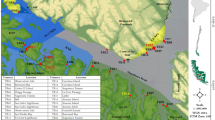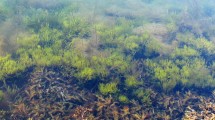Abstract
Kelp beds support diverse and productive benthic coastal ecosystems and are often perceived as cold water analogs of tropical coral reefs, yet the levels of species richness in polar regions have remained largely unexplored. The present study aims to assess the magnitude of macrozoobenthic species richness associated with the macroalgae in an Arctic kelp forest. The study was conducted in Hornsund, a high latitude Arctic fjord off west Spitsbergen (76–77°N). A total of 403 samples (i.e., individual algae) were collected by scuba divers at three sites located along the fjord axis at varying depths (5–10 m). The most common invertebrate species and the sample species richness (mean 11.5 species per sample) were consistent among the most common algal species (Laminaria digitata, Saccharina latissima, Alaria esculenta, Desmarestia aculeta, Odonthalia dentata, Phycodrys rubens). Fauna associated with overstory kelps was concentrated on the holdfasts. A total of 208 species were identified; Bryozoa, Polychaeta and Hydrozoa yielded the highest numbers of species (70, 52 and 37, respectively). The non-parametric Chao2 estimator of true species richness gave an estimate of 259 species (with 95% confidence intervals from 234 to 308). Despite the high sampling effort, the total species richness was not captured. This may stem from the high level of rarity within the fauna associated with kelps; 38% of the species occurred only in one or two samples. The studied fauna was much less diverse than similar assemblages surveyed at lower latitudes. The high numbers of species and the common occurrence of colonial forms (Bryozoa, Hydrozoa) in the current study show that these taxa cannot be omitted in macrobenthic diversity surveys performed within kelp habitats.






Similar content being viewed by others
References
ACIA (2005) Arctic climate impact assessment. Cambridge University Press, Cambridge
Adami ML, Gordillo S (1999) Structure and dynamics of the biota associated with Macrocystis pyrifera (Phaeophyta) from the Beagle Channel, Tierra del Fuego. Scientia Marina 63(Suppl 1):183–191
Anderson MJ, Diebel CE, Blom WM, Landers TJ (2005) Consistency and variation in kelp holdfast assemblages: spatial patterns of biodiversity for the major phyla at different taxonomic resolutions. J Exp Mar Biol Ecol 320:35–56. doi:10.1016/j.jembe.2004.12.023
Begin C, Johnson LE, Himmelman JH (2004) Macroalgal canopies: distribution and diversity of associated invertebrates and effects on the recruitment and growth of mussels. Mar Ecol Prog Ser 271:121–132. doi:10.3354/meps271121
Bouchet P, Louzet P, Maestrati P, Heros V (2002) Assessing the magnitude of species richness in tropical marine environments: exceptionally high numbers of molluscs at a New Caledonia site. Biol J Linn Soc Lond 75:421–436. doi:10.1046/j.1095-8312.2002.00052.x
Carlsen BP, Johnsen G, Berge J, Kuklinski P (2007) Biodiversity patterns of macro-epifauna on different lamina parts of Laminaria digitata and Saccharina latissima collected during spring and summer 2004 in Kongsfjorden, Svalbard. Polar Biol 30:939–943. doi:10.1007/s00300-007-0272-4
Christie H, Jorgensen NM, Norderhaug KM, Waage-Nielsen E (2003) Species distribution and habitat exploitation of fauna associated with kelp (Laminaria hyperborea) along the Norwegian coast. J Mar Biol Assoc UK 83:687–699. doi:10.1017/S0025315403007653h
Clarke KR (1993) Non-parametric multivariate analyses of changes in community structure. Aust J Ecol 18:117–143. doi:10.1111/j.1442-9993.1993.tb00438.x
Clarke KR, Warwick RM (1994) Changes in marine communities: an approach to statistical analysis and interpretation. Natural Environment Research Council, Plymouth Marine Laboratory, Plymouth
Colwell RK (2005) Estimates: statistical estimation of species richness and shared species from samples. Version 7.5. user’s guide and application. Available at: http://purl.oclc.org/estimates
Colwell RK, Mao CX, Chang J (2004) Interpolating, extrapolating, and comparing incidence-based species accumulation curves. Ecology 85:2717–2727. doi:10.1890/03-0557
Cornell HV, Lawton JH (1992) Species interactions, local and regional processes, and limits to the richness of ecological communities: a theoretical perspective. J Anim Ecol 61:1–12. doi:10.2307/5503
Crame JA (2000) Evolution of taxonomic diversity gradients in the marine realm: evidence from the composition of recent bivalve faunas. Paleobiology 26:188–214. doi:10.1666/0094-8373(2000)026<0188:EOTDGI>2.0.CO;2
Dayton PK, Mordida BJ, Bacon F (1994) Polar marine communities. Am Zool 34:90–99
Dunton K (1992) Arctic biogeography: the paradox of the marine benthic fauna and flora. Trends Ecol Evol 7:183–189. doi:10.1016/0169-5347(92)90070-R
Dunton KH, Reimnitz E, Schonberg S (1982) An Arctic kelp community in the alaskan Beaufort Sea. Arctic 35:465–484
Ellingsen KE, Gray JS (2002) Spatial patterns of benthic diversity: is there a latitudinal gradient along the Norwegian continental shelf? J Anim Ecol 71:373–389. doi:10.1046/j.1365-2656.2002.00606.x
Gili JM, Hughes RG (1995) The ecology of marine benthic hydroids. Ocean Mar Biol Ann Rev 33:351–426
Gili JM, Alvà V, Coma C, Orejas C, Pagés F, Ribes M, Zabala M, Arntz W, Bouillon J, Boero F, Hughes RG (1998) The impact of small benthic passive suspension feeders in shallow marine ecosystems: the hydroids as an example. Zool Verh 323:99–105
Görlich K, Węsławski JM, Zajączkowski M (1987) Suspension settling effect on macrobenthos biomass distribution in the Hornsund fjord, Spitsbergen. Polar Res 5:175–192. doi:10.1111/j.1751-8369.1987.tb00621.x
Graham MH (2004) Effects of local deforestation on the diversity and structure of southern California giant kelp forest food webs. Ecosystems (NY, print) 7:341–357. doi:10.1007/s10021-003-0245-6
Graham MH, Kinlan BP, Druehl LD, Garske LE, Banks S (2007) Deep-water kelp refugia as potential hot spots of tropical marine diversity and productivity. Proc Natl Acad Sci USA 104:16576–16580. doi:10.1073/pnas.0704778104
Gray JS (2000) The measurement of marine species diversity, with an application to the benthic fauna of the Norwegian continental shelf. J Exp Mar Biol Ecol 250:23–49. doi:10.1016/S0022-0981(00)00178-7
Jones DJ (1973) Variation in the trophic structure and species composition of some invertebrate communities in polluted kelp forests in the North Sea. Mar Biol (Berl) 20:351–365. doi:10.1007/BF00354277
Jones CG, Lawton JH, Shachak M (1994) Organisms as ecosystem engineers. Oikos 69:373–386. doi:10.2307/3545850
Lippert H, Iken K, Rachor E, Wiencke C (2001) Macrofauna associated with macroalgae in the Kongsfjord (Spitsbergen). Polar Biol 24:512–522. doi:10.1007/s003000100250
Magurran AE (2004) Measuring biological diversity. Blackwell, Malden
Mohr JL, Wilimovsky NJ, Dawson EY (1957) Arctic Alaskan kelp bed. Arctic 10:45–52
Moore PG (1972) The kelp fauna of northeast Britain. I. Introduction and the physical environment. J Exp Mar Biol Ecol 13:97–125. doi:10.1016/0022-0981(73)90073-7
Norderhaug KM, Christie H, Rinde E (2002) Colonisation of kelp imitations by epiphyte and holdfast fauna: a study of mobility patterns. Mar Biol (Berl) 141:965–973. doi:10.1007/s00227-002-0893-7
Ojeda FP, Santelices B (1984) Invertebrate communities in holdfasts of the kelp Macrocystis pyrifera from southern Chile. Mar Ecol Prog Ser 16:65–73. doi:10.3354/meps016065
Orejas C, Gili JM, Alvà V, Arntz W (2000) Predatory impact of an epiphytic hydrozoan in an upwelling area in the Bay of Coliumo (Dichato, Chile). J Sea Res 44:209–220. doi:10.1016/S1385-1101(00)00057-5
Rios C, Arntz WE, Gerdes D, Mutsche E, Montiel A (2007) Spatial and temporal variability of the benthic assemblages associated to the holdfasts of the kelp Macrocystis pyrifera in the Straits of Magellan, Chile. Polar Biol 31:89–100. doi:10.1007/s00300-007-0337-4
Ronowicz M (2007) Benthic hydroids (Cnidaria: Hydrozoa) from Svalbard waters: biodiversity and distribution. J Mar Biol Assoc UK 87:1089–1094. doi:10.1017/S0025315407055142
Różycki O, Gruszczyński M (1986) Macrofauna associated with laminarians in the coastal waters of West Spitsbergen. Pol Polar Res 7:337–351
Saloranta TM, Svendsen H (2001) Across the Arctic front west of Spitsbergen: high-resolution CTD sections from 1998 to 2000. Polar Res 20:177–184. doi:10.1111/j.1751-8369.2001.tb00054.x
Schultze K, Janke K, Krub A, Weidemann W (1990) The macrofauna and macroflora associated with Laminaria digitata and L. hyperborea at the island of Helgoland (German Bight, North Sea). Helgol Wiss Meeresunters 44:39–51. doi:10.1007/BF02365430
Smith SDA (1996) The macrofaunal community of Ecklonia radiata holdfasts: variation associated with sediment regime, sponge cover and depth. Aust J Ecol 21:144–153. doi:10.1111/j.1442-9993.1996.tb00595.x
Smith SDA, Simpson RD (1993) Effects of pollution on holdfast macrofauna of the kelp Ecklonia radiata: discrimination at different taxonomic levels. Mar Ecol Prog Ser 96:199–208. doi:10.3354/meps096199
Smith SDA, Simpson RD, Cairns SC (1996) The macrofaunal community of Ecklonia radiata holdfasts: description of the faunal assemblage and variation associated with differences in holdfast volume. Aust J Ecol 21:81–95. doi:10.1111/j.1442-9993.1996.tb00587.x
Steneck RS, Graham MH, Bourque BJ, Corbett D, Erlandson JM, Estes JA, Tegner MJ (2002) Kelp forest ecosystems: biodiversity, stability, resilience and future. Environ Conserv 29:436–459. doi:10.1017/S0376892902000322
Svendsen P (1959) Algal vegetation of Spitsbergen: a survey of the marine algal flora of the outer part of Isfjorden. Nor Polarinstitut Skrift 116:1–47
Swerpel S (1985) The Hornsund fjord: water masses. Pol Polar Res 6:475–496
Walther BA, Moore JL (2005) The concepts of bias, precision and accuracy, and their use in testing the performance of species richness estimators with a literature review of estimator performance. Ecography 28:815–829. doi:10.1111/j.2005.0906-7590.04112.x
Węsławski JM, Zajączkowski M, Kwaśniewski S, Jezierski J, Moskal W (1988) Seasonality in an Arctic fjord ecosytsem: Hornsund, Spitsbergen. Polar Res 6:185–189. doi:10.1111/j.1751-8369.1988.tb00596.x
Węsławski J, Kwaśniewski S, Stempniewicz L, Błachowiak-Samołyk K (2006) Biodiversity and energy transfer to top trophic levels in two contrasting Arctic fjords. Polar Res 27:256–278
Witman JD, Etter RJ, Smith F (2004) The relationship between regional and local species diversity in marine benthic communities: a global perspective. Proc Natl Acad Sci USA 101:15664–15669. doi:10.1073/pnas.0404300101
Acknowledgments
We would like to thank B. Witalis and T. Kirzeniewski for help with field work in Hornsund. The study was completed thanks to the funding provided by grant N304 034311202 from the State Committee for Scientific Research.
Author information
Authors and Affiliations
Corresponding author
Rights and permissions
About this article
Cite this article
Włodarska-Kowalczuk, M., Kukliński, P., Ronowicz, M. et al. Assessing species richness of macrofauna associated with macroalgae in Arctic kelp forests (Hornsund, Svalbard). Polar Biol 32, 897–905 (2009). https://doi.org/10.1007/s00300-009-0590-9
Received:
Revised:
Accepted:
Published:
Issue Date:
DOI: https://doi.org/10.1007/s00300-009-0590-9




